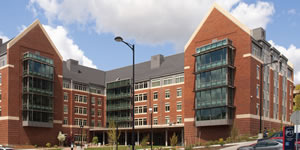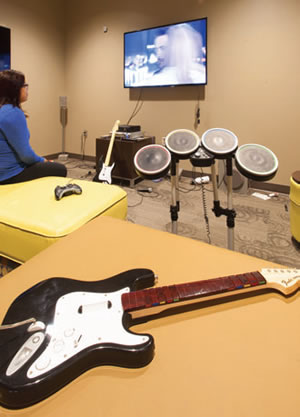A Future-Proof Residence Hall
- By Richard Parrish
- 12/01/14

PHOTOS © TYLER TJOMSLAND
Richard Parrish is president of MindShare
Communications, which specializes in
developing timely, relevant feature stories
about organizations that are making a difference
in a broad range of industries and
professions. He can be reached at [email protected].
At first glance, the brand
new, 112,000-square-foot student
residence hall on the campus of
Eastern Washington University (EWU) in
Cheney, WA, is reminiscent of a gabled-roof,
redbrick dorm at an Ivy League school. However,
beneath the traditional-looking exterior
of EWU’s newest building are advanced
technologies and amenities that enhance
communications and learning for today’s
students. The building is also future-proofed
to be compatible with technologies yet to
come, and has earned a LEED Silver rating.
The school’s leadership also wanted
the new building to be a monument to the
cultural heritage of that region and chose
to name the new building snyamncut (pronounced
sin-yam-en-suit). The name comes
from the Salish language of the Spokane Indian
tribe and means a place of gathering for
rest, relaxation and decision making. Salish
words are not capitalized, so the name of the
new hall will always be in lowercase letters.
Josh Ashcroft, EWU’s chief housing officer, says, “We view snyamncut as really the
new standard to move forward, as we continue
to upgrade our other buildings. We’re
very happy with the new facility and know
it will meet the needs of today and tomorrow,
and hope that we can get the rest of our
facilities up to that standard over time.”
The nervous system of the new, five-story
co-ed residence hall, which opened
earlier this year, is 241,000 linear feet — or
45 miles — of advanced Category 6 cable that
delivers TV signals, telephone and Internet
for 10BASE-T, 100BASE-TX (Fast Ethernet),
1000BASE-T/1000BASE-TX (Gigabit Ethernet)
and 10GBASE-T (10-Gigabit Ethernet). Equally
important, the cable transfers data at very high
speeds due to its ability to minimize “pair-topair
crosstalk,” and it reduces system noise.
Pillow Talk
The second through fifth floors of
snyamncut each have 43 rooms that
altogether house more than 400 students,
according to Bill Turlington, EWU’s
Information Technology specialist. “We
refer to the residents as pillows,” he says.
“Most rooms have two pillows, but some
have three pillows. Every pillow gets a
gigabit network data connection and each
room has one TV connection. The students
provide their own computers and TV.”
The ground floor has a large conference
room with a fireplace, and a drop-down screen and projector that is connected to the building’s
TV network. Student groups use the room for
meetings and other activities. Housing and
Residence Hall Association offices and several
public spaces are also located on this floor.
Long before any students laid their heads
down on pillows at snyamncut, Turlington
and his supervisor, Karl Riel, Infrastructure
and Communications manager, talked about
installing an alternative to a conventional
cable TV network. Turlington says, “We
were interested in a system that will allow
us to future-proof the building for years to
come and be ready for IPTV, which is still in
its infancy, or any other alternative.”

PHOTOS © TYLER TJOMSLAND
The basic design of the building was drawn
early in 2012, and in May of that year ground
was broken. In March of the following year,
Riel happened to see the Lynx Broadband TV
network demonstrated at the ACUTA Show
(Association of College and University Telecommunications
Administrators).
Soon after that show, Ray Fugitt, Lynx’
regional sales manager, visited with Riel
and Turlington, and provided another
demonstration of the TV system. In July
2013, Fugitt completed the design of the
cabling layout for the TV network in
snyamncut, which was accepted by the
school and approved by the state. Installation
began the following September.
Hitting A Home Run
The installed system involves RF baluns
in hubs that receive “unbalanced” TV signals
from any source (cable, satellite or video),
and then convert them to “balanced”
signals that travel on Cat 6 cable to the point
of use. There a single port converter turns
the signal back to an “unbalanced” signal
that enters the TV through a coaxial cable.
A significant advantage of a Cat 6 TV
network, such as the one at snyamncut,
is improved signal quality and reliability,
because there are no taps, splitters or other
connectors between the hubs in a wiring
closet and the TV sets on each floor. “The
picture quality is excellent, too,” Turlington
adds. The system uses a “homerun”
network that hooks up one Cat 6 cable
directly to one TV, which greatly simplifies
installation and troubleshooting.
Installation of 17 16-port hubs, one
8-port hub and more than 300 single-port
converters was performed in only six
days by certified installers Sean Haines
and Alex Yamnik. That’s enough ports to
connect TVs in all of the resident rooms in
the building, plus TVs in student lounges,
game rooms and other public areas
throughout snyamncut, and still have ports
available for additional use, if needed.
Haines and Yamnik connected coax
cables from the headend closet on the main
floor of the building to hubs on each of the
above floors. “Those two guys would come
in early in the morning and worked till six or
seven o’clock in the evening, and they kept at
it until they were finished,” Turlington says.
Heating Things Up
“Making the installation a little more
challenging was the fact that the elevators
were not in service yet, there was no
air conditioning, and the temperatures
averaged from 80 to 100 degrees,” he
continues. The primary TV signals come
into the headend by coaxial cable from
Davis Cable Company, a local provider of
90 channels, including 14 optional HDTV
channels. The school’s own channel is
also carried on the system.
“One of the more important things about
installing this network system was balancing
the signal strength over each Cat 6 cable to a TV,” Haines says. “The idea
is to make sure a TV that’s 200 feet away
(from a hub) gets the same quality signal
and picture as a TV that’s only 30 feet away.”
All of the coax cable from the headend to
the wiring closets on each floor, along with
all of the Cat 6 cable, was already installed
throughout the building before Haines and
Yamnik arrived on the scene. That allowed
them to focus on the TV hookups and make
sure they were installed properly, then connect
the Cat 6 cables from the hubs to TVs,
modify signal strength as needed, and work
with Davis Cable to assure the building was
receiving the best possible TV signals.
Besides a TV connection in every dorm
room, other TVs hooked up to the network
are located in a lounge and three or four
study rooms on each of the above-ground
floors. “Not only do students have a gigabit
connection in their rooms, they can also
access an advanced WiFi system for all
of their laptops, cell phones and other
devices,” Turlington continues. The system
has six hot zones per floor; 30 in all.
All told, the cost of the cabling and installation
throughout the building; the hubs,
connectors and installation; headend closet
on the first floor; wiring closets on the other
four floors; data processing, WiFi and related
equipment; their installation; and 22 flat
screen TVs in public spaces cost $800,000,
the school says, which is only 3.2 percent of
the $25 million cost for the entire building.
Other Features
In addition, students have access to a
full-service kitchen on each floor, as well as
two video and two non-video game rooms in
the building. The latter have billiard tables,
Ping-Pong and other games.
“We also installed 60 IP cameras for
security in the stairwells and at all the
entrances to snyamncut,” Turlington says.
There are three stairwells and 15 landings.
The exterior of the building is also monitored
on camera, and all of these security cameras
are connected to a video recording service.
But that’s not all. Each floor is equipped
with a laundry room that has advanced
washing machines and dryers hooked up to
the Internet. The machines alert students
when they are available and when their
clothes are done. Also, students do not
need to worry about slogging through deep
snow and ice on walkways surrounding the
building, because they are all heated.
This article originally appeared in the issue of .